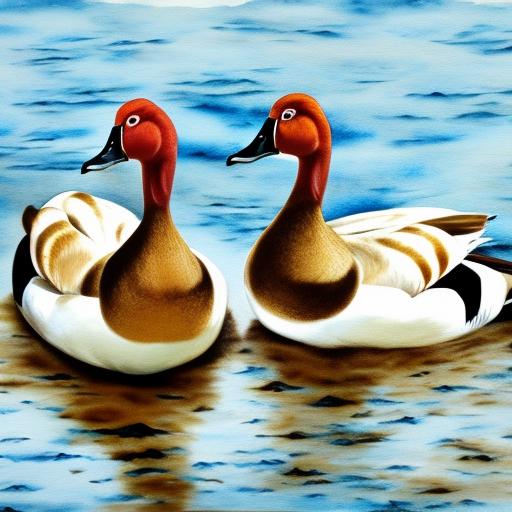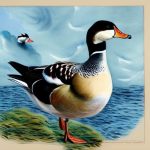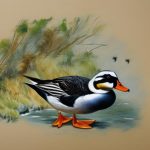Ducks are a popular choice for poultry enthusiasts due to their charming personalities, low maintenance, and ability to lay eggs. When it comes to duck breeds, there are a wide variety of colors and patterns to choose from. Two popular color variations are brown and white duck breeds. Brown duck breeds typically have rich, earthy tones in their feathers, while white duck breeds have a clean, pristine appearance. Each color variation has its own unique characteristics, behaviors, and temperament that make them suitable for different purposes and environments. Whether you’re looking to add ducks to your farm, backyard, or homestead, understanding the differences between brown and white duck breeds can help you make an informed decision when choosing the right breed for your needs.
Key Takeaways
- Brown and white duck breeds are popular choices for backyard poultry enthusiasts due to their unique characteristics and temperaments.
- Brown duck breeds are known for their hardiness, foraging abilities, and excellent egg-laying capabilities.
- White duck breeds are prized for their calm and docile nature, making them great foragers and ideal for small backyard settings.
- Brown duck breeds tend to be more active and independent, while white duck breeds are known for their gentle and friendly disposition.
- Popular brown duck breeds include the Khaki Campbell, Indian Runner, and Saxony, while popular white duck breeds include the Pekin, Aylesbury, and White Crested.
Characteristics of Brown Duck Breeds
Brown duck breeds are known for their warm and earthy coloration, which can range from deep chocolate brown to lighter shades of tan. These ducks often have striking patterns and markings on their feathers, adding to their visual appeal. In addition to their coloration, brown duck breeds are typically hardy and adaptable to various climates. They are known for their foraging abilities and can thrive in free-range environments. Brown duck breeds are also excellent layers, with many breeds laying large, white eggs. They are known for their maternal instincts and make good broody hens, making them ideal for hatching and raising ducklings. In terms of size, brown duck breeds can vary from medium to large, with sturdy builds that make them resilient to predators and harsh weather conditions.
On the downside, some brown duck breeds can be more prone to broodiness, which may affect their egg production. Additionally, their darker coloration may make them more susceptible to overheating in hot climates. It’s important to provide adequate shade and water for brown duck breeds to ensure they stay cool and comfortable. Overall, brown duck breeds are prized for their beauty, hardiness, and egg-laying abilities, making them a popular choice for both small-scale and commercial duck farming.
Characteristics of White Duck Breeds
White duck breeds are known for their clean and pristine appearance, with pure white feathers that give them a striking and elegant look. Their white plumage makes them stand out in any flock and adds a touch of brightness to the environment. In addition to their appearance, white duck breeds are often prized for their calm and docile temperament. They tend to be friendly and easy to handle, making them suitable for families with children or those looking for a pet duck. White duck breeds are also known for their excellent egg-laying abilities, with many breeds laying large, white eggs that are highly sought after for their quality and taste. They are also good foragers and can adapt well to free-range environments.
One potential drawback of white duck breeds is that their light coloration may make them more susceptible to predators, especially in rural or wooded areas. It’s important to provide adequate protection and secure housing for white duck breeds to keep them safe from potential threats. Additionally, some white duck breeds may be more prone to being flighty or skittish, requiring gentle handling and socialization to build trust. Despite these considerations, white duck breeds are popular for their beauty, gentle nature, and reliable egg production, making them a desirable choice for both small-scale and backyard duck enthusiasts.
Differences in Behavior and Temperament
When it comes to behavior and temperament, brown and white duck breeds can exhibit distinct characteristics that make them suitable for different purposes and environments. Brown duck breeds are often known for their hardiness, adaptability, and maternal instincts. They tend to be good foragers and can thrive in free-range environments, making them ideal for farms or homesteads with ample space for grazing. Brown duck breeds are also known for their broody nature, making them excellent mothers for hatching and raising ducklings. On the other hand, white duck breeds are prized for their calm and docile temperament. They tend to be friendly and easy to handle, making them suitable for families with children or those looking for a pet duck. White duck breeds are also known for their reliable egg-laying abilities, making them a popular choice for those seeking a consistent supply of fresh eggs.
In terms of social dynamics, brown duck breeds may exhibit more assertive behavior within the flock, especially during breeding season or when establishing a pecking order. They may also be more independent and self-sufficient compared to white duck breeds. In contrast, white duck breeds tend to be more sociable and less aggressive towards other ducks, making them easier to integrate into mixed flocks or communal living arrangements. Understanding these differences in behavior and temperament can help you choose the right breed based on your specific needs and preferences.
Popular Brown Duck Breeds
Several popular brown duck breeds are favored by poultry enthusiasts for their unique characteristics and qualities. The Indian Runner is a slender and upright breed known for its excellent egg-laying abilities and distinctive upright stance. The Cayuga is a medium-sized breed with stunning iridescent greenish-black plumage that appears almost black in low light. They are prized for their calm temperament and reliable egg production. The Welsh Harlequin is a dual-purpose breed known for its beautiful silver or golden brown plumage and excellent egg-laying abilities. The Buff is a medium-sized breed with soft buff-colored feathers that is prized for its friendly nature and good egg production. These brown duck breeds are just a few examples of the many options available to poultry enthusiasts looking to add diversity to their flock.
Popular White Duck Breeds

White duck breeds are also popular choices among poultry enthusiasts due to their striking appearance and reliable egg-laying abilities. The Pekin is a large and robust breed with pure white feathers and a calm temperament. They are known for their excellent meat production as well as egg-laying abilities. The White Crested is a medium-sized breed with a distinctive crest on its head that sets it apart from other ducks. They are prized for their friendly nature and good egg production. The Khaki Campbell is a dual-purpose breed known for its khaki-colored plumage and exceptional egg-laying abilities. The Aylesbury is a large breed with pure white feathers that is prized for its meat production as well as its reliable egg-laying abilities. These white duck breeds offer a range of options for poultry enthusiasts looking to add beauty and productivity to their flock.
Considerations for Choosing a Brown or White Duck Breed
When choosing between brown and white duck breeds, there are several considerations to keep in mind to ensure you select the right breed for your specific needs and environment. If you’re looking for ducks with excellent egg-laying abilities and maternal instincts, brown duck breeds may be the ideal choice due to their hardiness and broody nature. On the other hand, if you’re seeking ducks with a calm temperament and reliable egg production, white duck breeds may be the better option due to their gentle nature and consistent laying habits.
It’s also important to consider the climate and environment in which you plan to raise ducks. Brown duck breeds may be better suited for free-range environments with ample space for grazing, while white duck breeds may thrive in smaller backyard settings with secure housing and protection from predators. Additionally, consider your own preferences for appearance, size, and social dynamics within the flock when choosing between brown and white duck breeds.
In conclusion, both brown and white duck breeds offer unique characteristics, behaviors, and qualities that make them suitable for different purposes and environments. Whether you’re looking for excellent egg-layers, reliable meat production, or friendly pet ducks, there are plenty of options available within each color variation. By understanding the differences between brown and white duck breeds, you can make an informed decision when choosing the right breed to add to your flock or homestead. With proper care and consideration of their specific needs, both brown and white duck breeds can bring joy, productivity, and beauty to your poultry endeavors.
If you’re considering raising brown and white duck breeds, you may also be interested in exploring large chicken coop ideas. A well-designed coop is essential for the health and happiness of your poultry. Check out this article on large chicken coop ideas for inspiration on creating a comfortable and functional living space for your ducks and chickens.
FAQs
What are some common brown and white duck breeds?
Some common brown and white duck breeds include the Welsh Harlequin, Saxony, and Silver Appleyard.
What are the characteristics of brown and white duck breeds?
Brown and white duck breeds typically have a combination of brown and white feathers, with variations in patterns and markings. They are known for their friendly and docile nature, making them popular choices for backyard flocks.
What are the uses of brown and white duck breeds?
Brown and white duck breeds are often raised for their meat, eggs, and pest control abilities. They are also kept as pets and for exhibition purposes.
What are the care requirements for brown and white duck breeds?
Brown and white duck breeds require access to water for swimming and bathing, a balanced diet of commercial duck feed and fresh greens, and protection from predators. They also need adequate shelter and space to roam.
Are brown and white duck breeds good for beginners?
Yes, brown and white duck breeds are generally good for beginners due to their friendly nature and ease of care. However, it’s important for beginners to research and understand the specific needs of the breed they choose.
Meet Walter, the feathered-friend fanatic of Florida! Nestled in the sunshine state, Walter struts through life with his feathered companions, clucking his way to happiness. With a coop that’s fancier than a five-star hotel, he’s the Don Juan of the chicken world. When he’s not teaching his hens to do the cha-cha, you’ll find him in a heated debate with his prized rooster, Sir Clucks-a-Lot. Walter’s poultry passion is no yolk; he’s the sunny-side-up guy you never knew you needed in your flock of friends!







